The Horse Impressionists
Lucy Gunning
1964, Newcastle upon Tyne (United Kingdom)
Lives and work in London (United Kingdom)
The Horse Impressionists, 1994
Betacam SP, PAL, color, sound
7 min. 30 sec.
Purchase, 1998
Centre Pompidou, Paris
Musée national d’art moderne - Centre de création industrielle (Mnam-CCI)
AM 1998-245
Lucy Gunning est une artiste britannique née en 1964 à Newcastle upon Tyne. Elle étudie la sculpture avant de rejoindre en 1993 le Goldsmiths College de Londres, où la performance et le théâtre nourrissent ses premières œuvres filmiques. Caméra Super 8 à l’épaule, elle capte sur le vif des situations orchestrées ou non, où se déploient des expériences humaines singulières.
Dans The Horse Impressionists, Lucy Gunning filme des femmes imitant des chevaux grâce à des performances vocales hors du commun. À travers les cadrages resserrés, les différents points de vue et le nombre restreint de plans, l’artiste semble vouloir capter au plus juste ce qui se passe dans les corps, les sensations et les émotions. Prenant le jeu au sérieux, certaines femmes hennissent, d’autres soufflent, grondent, gonflent les joues et le cou, s’ébrouent, font trembler leurs lèvres ou claquer leurs talons. Conscientes de livrer une part d’intimité, elles sourient, gênées, intimidées ou amusées. La caméra se pose au seuil de leurs zones de confort.
Lucy Gunning a rencontré ces femmes via une petite annonce. Étant enfant, elle-même jouait souvent à être un cheval. Plus tard, elle s’est rendu compte que les femmes de son entourage, davantage que les hommes, partageaient encore pour beaucoup d’entre elles cette relation particulière aux chevaux. Elle a ainsi voulu filmer ces pratiques, autant que les situations de dévoilement et d’incongruité que sa proposition génère.
- Read more about The Horse Impressionists
- Log in or register to post comments
Julie Champion-Lagadec
Lucy Gunning
<Parler de loin ou bien se taire>
Anne Le Troter
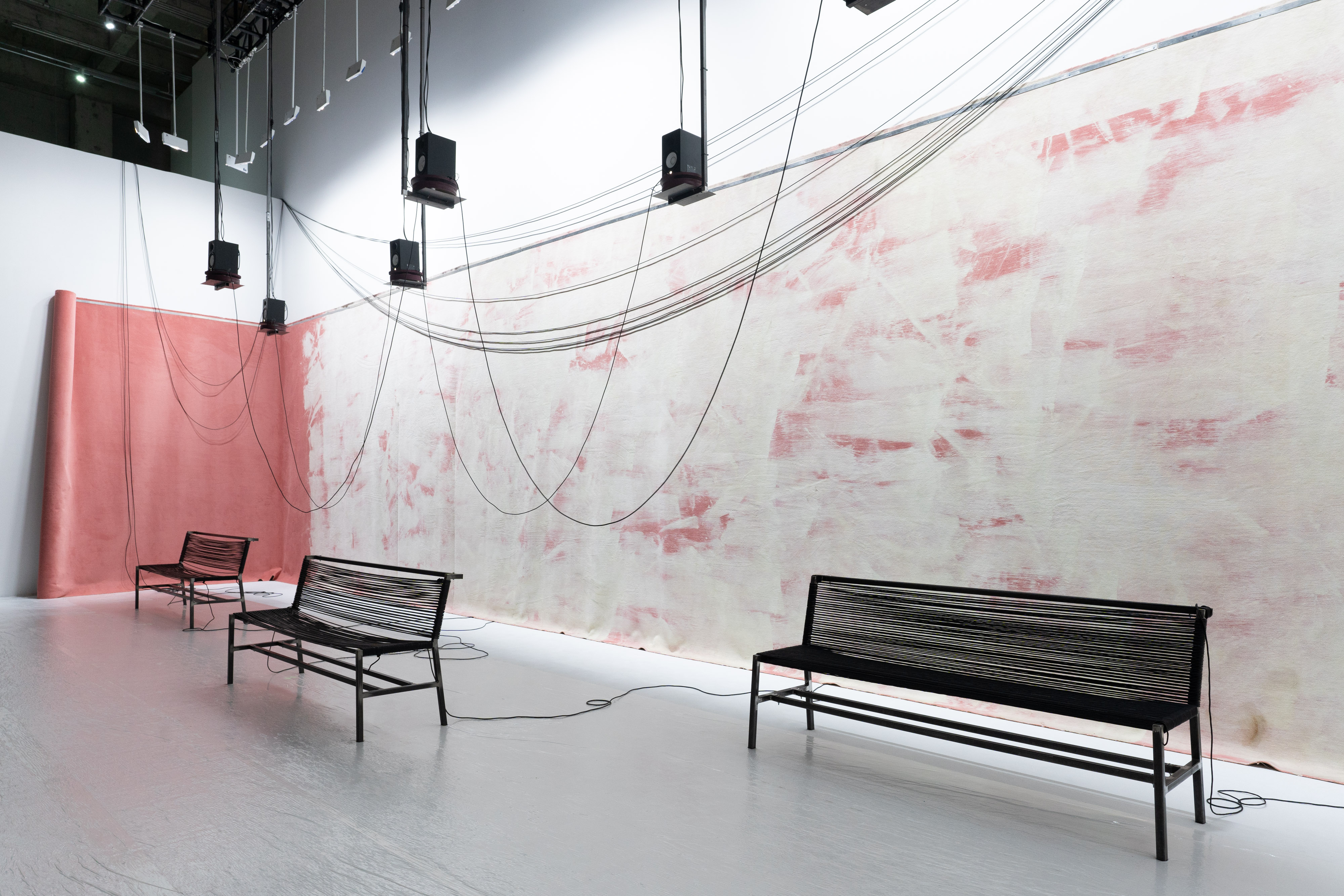
Parler de loin ou bien se taire, 2019
Sound installation
Variable dimensions
Faded pink carpet, 3 benches, audiovisual cables, 6 speakers, electronic control system, sound card, computer, 6 digital audio files, Chinese version
20min
Performed by Gu Xiaoliang, Charlotte Lassansaa, Li Gang, Wang Hao,
Zhang Moyu, Zheng Yongsong, Zhou Chenxin, Wang Luqing, with
contribution from Zhang Hui
Gift from Amis du the Centre Pompidou, 2020
Centre Pompidou, Paris
Musée national d'art moderne / Centre de création industrielle (Mnam / Cci)
AM 2020-421
Through poetry, performance, and installation, Anne Le Troter's sound work explores the mechanisms of language. Focusing primarily on sociolects, the dialects of a particular social class or professional group, her works are made up of words that have been collected, cut up, and reassembled.
In Parler de loin ou bien se taire (“At distance speak, or hold your tongue”), Le Troter created portraits of anonymous people on the basis of 400 interviews conducted by a sperm bank with its donors as well as comments by the business’ employees. The artist shows how, within a body of work, word choice, syntax, and intonation transformed the donors into stereotyped, ‘marketable’ characters. The resulting sound composition, described by the artist as a "pre-adolescent nursery rhyme, naïve and intoxicating", engenders a sense of confusion: the voices seem to evoke a single person rather than several hundred individuals.
As is often the case with the artist's work, the sound piece unfolds within an installation conceived as a collective listening environment. The sound is diffused by loudspeakers placed on rotating trays, so that the cables connecting them stretch and relax as if in a breathing movement. Conjuring up an imaginary world that is both organic and medical, this space responds to the artist's desire to give "the spoken word a territory and a body".
- Read more about
- Log in or register to post comments
<Me Singing Stay By Rihanna>
Molly Soda
1989, San Juan (Porto Rico)
Lives and works in New York (United States)
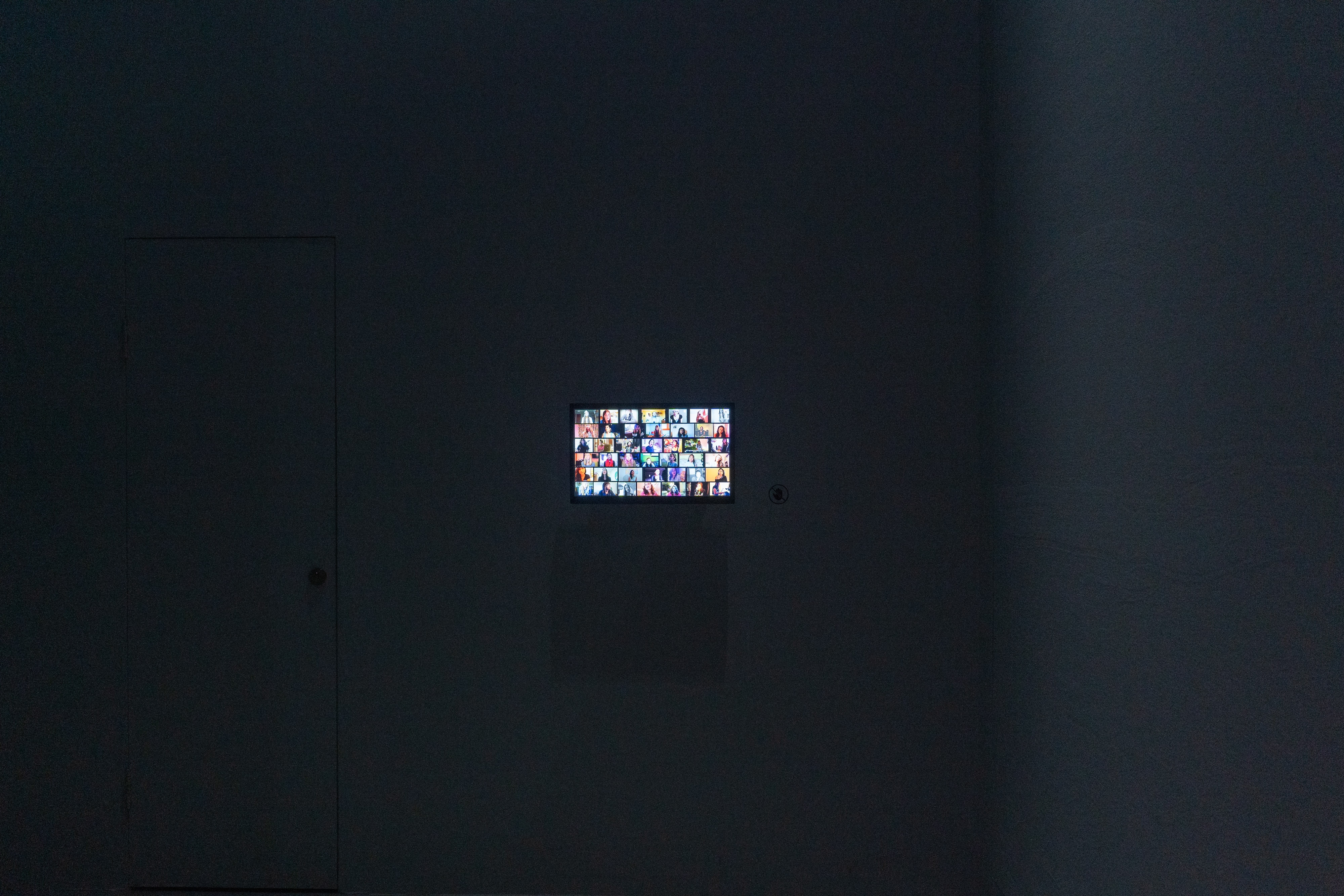
Me Singing Stay By Rihanna, 2018
Digital video
16:9, colour, sound
4 minutes 29 seconds
Purchase, 2023
Centre Pompidou, Paris
Musée national d'art moderne / Centre de création industrielle (Mnam / Cci)
AM 2023-709
Born in 1989, Amalia Soto, working under the pseudonym Molly Soda, has developed an extensive body of online art analysing digital cultures, specifically the mechanisms of self-exposure on the internet. Whether through self-filmed videos, GIF files or interventions on social networks, Molly Soda explores the relationship between private and public life that structures the digital image of young contemporary women. In a work that subverts these platforms, she hijacks or amplifies the particularly gendered codes of amateur online productions, adapting historical feminist artistic strategies to the contemporary media landscape.
Me Singing Stay by Rihanna, created in 2018, exemplifies her exploration of the bedroom culture, and on the articulation between public and private life that marks the generation of digital natives. The work deals with amateur practice of making covers of popular songs, both contemporary and older, online, face-to-face, predominantly by solo women. Molly Soda synchronised dozens of performances of Rihanna's Stay to reflect on the emotional power of music and the standardisation of intimacy. In a mosaic of melancholy portraits, she shifts from the solitary individual to the community, from self-portraits to the chorus, and from amateurism to the music industry.
- Read more about
- Log in or register to post comments
<Stranger>
Naama Tsabar
1982, Tel-Aviv (Israel)
Lives and works in New York (United States)
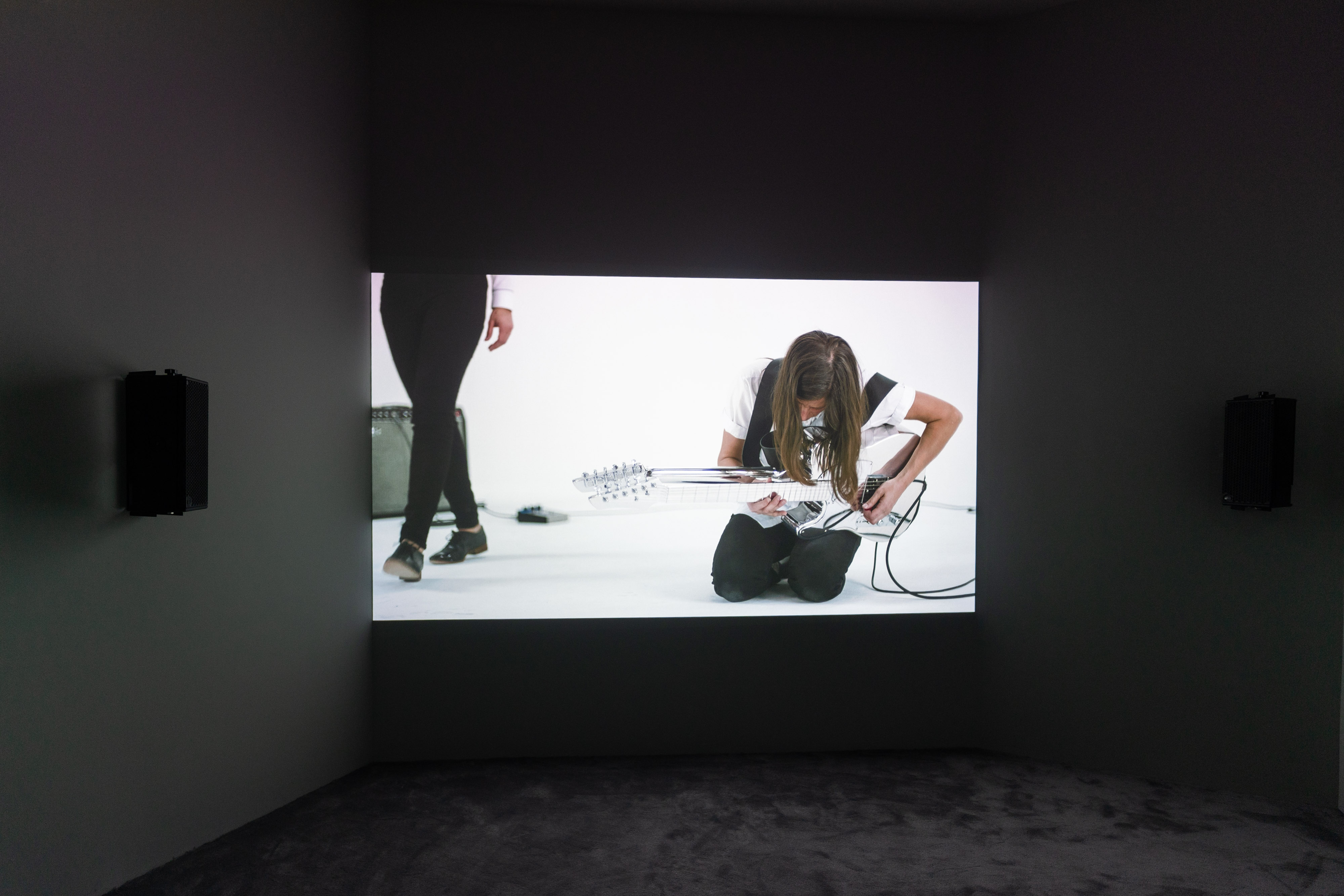
Stranger, 2017
Digital video
16:9, colour, sound
11 minutes 34 seconds
Gift from Fonds Artis–Amis du Centre Pompidou, 2022
Centre Pompidou, Paris
Musée national d'art moderne / Centre de création industrielle (Mnam / Cci)
AM 2022-667
Trained as a child on piano and guitar, and having played in a number of punk bands, Naama Tsabar focuses on analysing and deconstructing the codes of amplified music and the power structures at work within it. Working from a strong feminist perspective, she is particularly interested in the visual and aural culture of rock and the gender stereotypes associated with this predominantly male music scene.
Stranger takes as its starting point an instrument created by the artist: a double electric guitar, consisting of two instruments connected back to back, which can be used by two performers. The performers are not placed in a position of authority – as is the dominant and solitary image of the guitarist on stage at a rock concert – but in a closeness necessitated by the very shape of the instrument, which forces its players into a constant negotiation. Initially showing the artist playing this counter-intuitive instrument alone, the video then focuses on the four hands that activate it, leaving in turn her collaborator, the musician and sound engineer Kristin Mueller, alone. The mirroring effect of the brushed metal on the instrument is echoed in the positions of the performers' bodies, facing each other, intermingled, pushing one way and then another, at times seeming to merge into a single person, always with their backs to the audience.
- Read more about
- Log in or register to post comments
<Les Pissenlits>
Michel Bret
1941, Lyon (France)
Lives and works in Saint-Leu-la-Forêt (France)
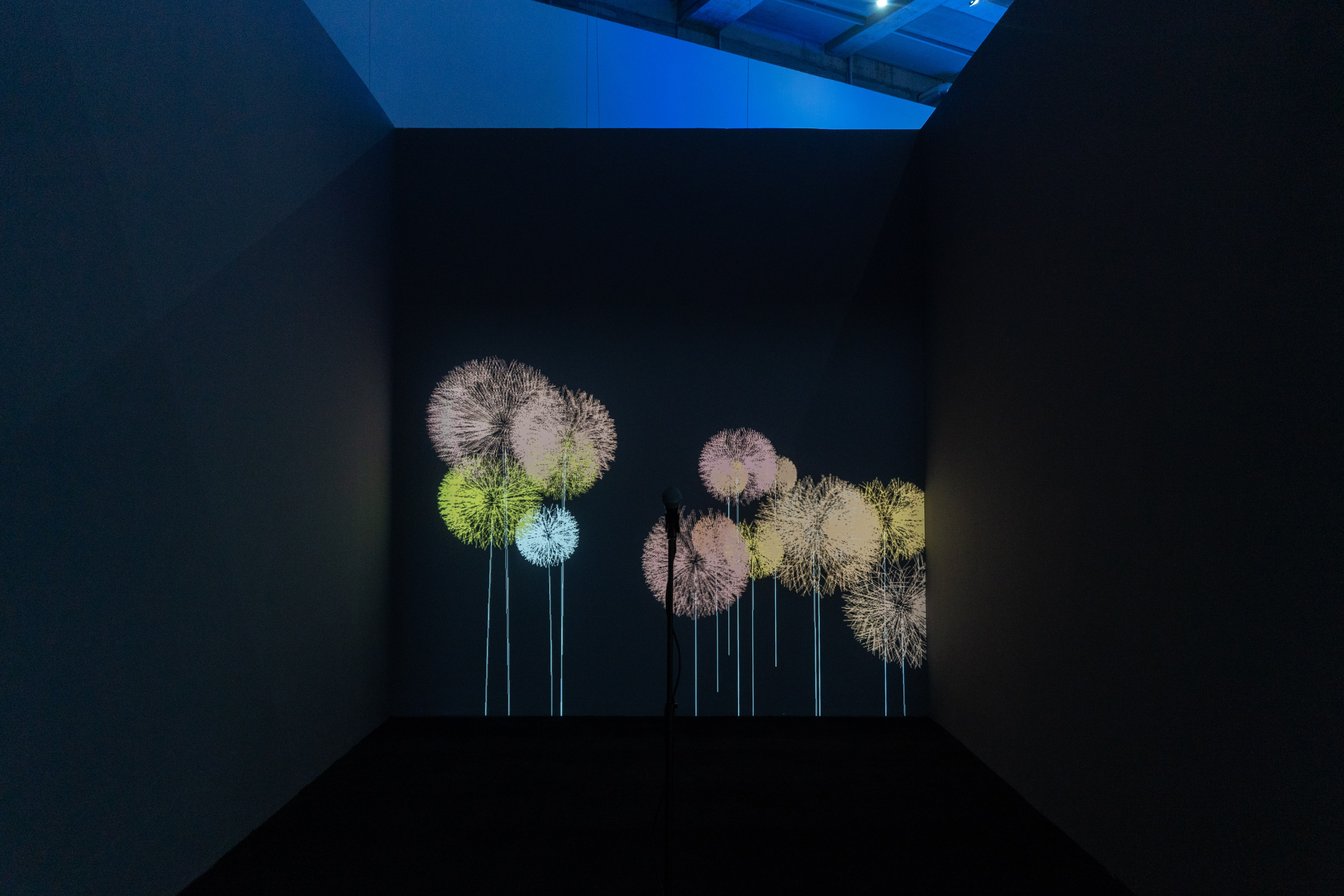
Edmond Couchot
1932, Alger (Algeria)–2020, Paris (France)
Les Pissenlits, 1990-2005
Interactive installation
Custom software, video projection, microphone
Variable dimensions
Gift from Marie-Hélène Tramus and Michel Bret, 2024
Centre Pompidou, Paris
Musée national d'art moderne / Centre de création industrielle (Mnam / Cci)
AM 2024-181
Both in their teaching and their art, Michel Bret and Edmond Couchot were prominent figures in digital creation in France. The latter turned to this field after a career as a painter; in the 1960s, he produced luminokinetic paintings that reacted to musical compositions of his own choosing. The former began developing computer programmes in the 1970s, from which he created a large body of works in motion.
In 1988, in collaboration with Marie-Hélène Tramus, they created their first interactive work, which featured the image of a feather floating in the air in response to the viewer's as they blew into a microphone. Two years later, they continued their research using an analogue device: the pistils of a virtual dandelion were released in response to the visitor's breath. This work evolved into Les Pissenlits (Dandelions), with the increase in computer power allowing for the simulation of several plants simultaneously. The images produced in this work are not pre-calculated but generated in real time based on the intensity of the blowing, making them unique to each viewer. As Couchot explained, "The image’s life may depend on a single breath. But in that breath, it also gains the power to be reborn elsewhere, differently, ultimately becoming more than just one image.”
- Read more about
- Log in or register to post comments
Philippe Bettinelli
<Sound Temple>
Sun Wei
1976, Beijing (China)
Lives and works in Chengdu (China)
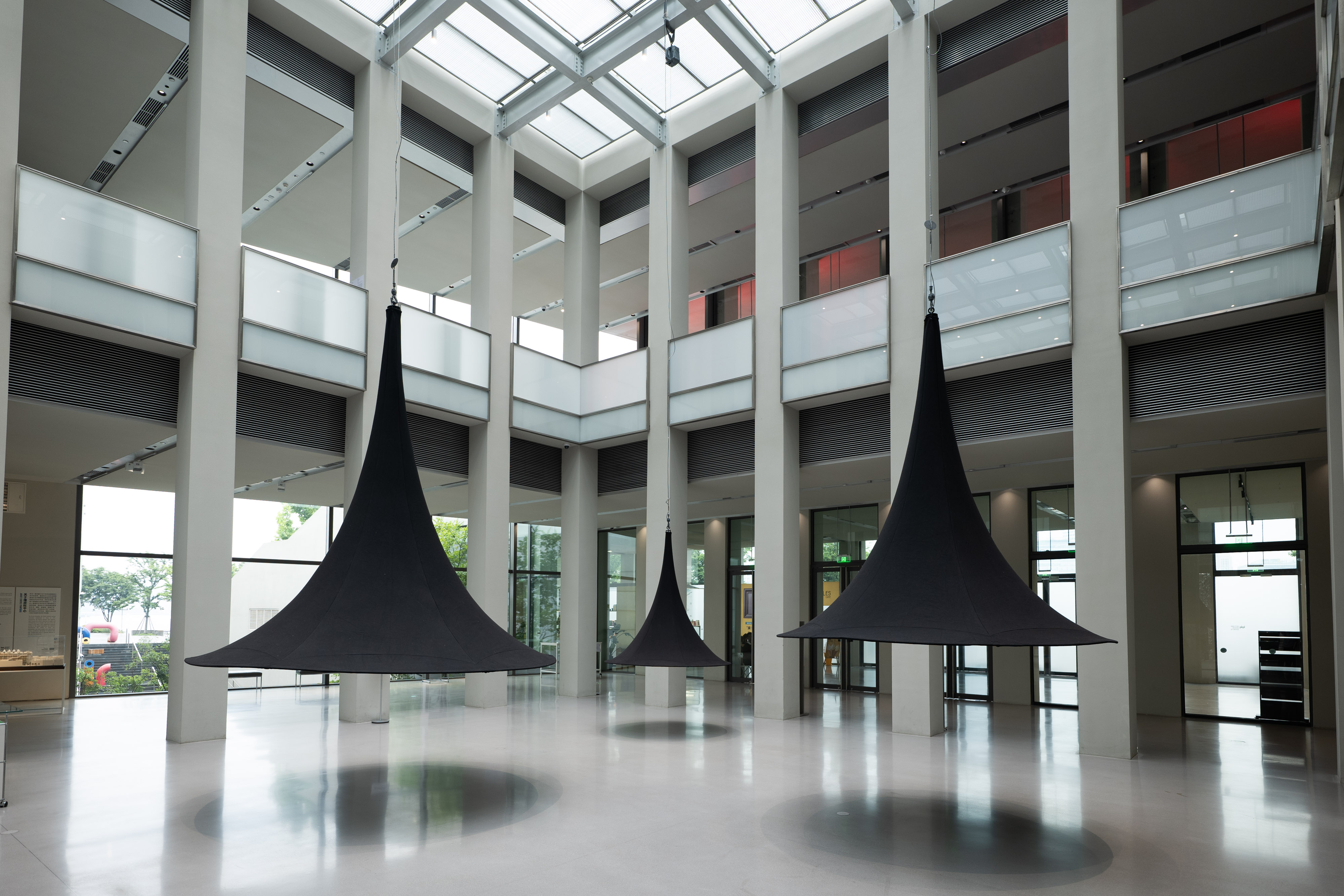
Sound Temple, 2021
Sound installation
3 acoustic canvas hoods, 3 mono speakers, 3 audio files
Courtesy of the artist
Sun Wei is a sound and field recording artist whose work explores the diversity of auditory frequencies and the relationship between acoustic vibrations and the environment. His works include ultrasonic recordings of nature, underwater frequencies and the background noises of everyday life.
In Sound Temple, the artist questions the way in which sound enables individuals to access spirituality, observing how the sonic context distinguishes the temples of Taiyuan, Shanxi Province, from those of other cities. Sun Wei shows how the temples of the schools of different cultural systems and the sounds that surround them reflect the contrasts between the technological frenzy of cities and the atmosphere created by religious cultures. This installation presents a transformed version of sounds collected online at different frequencies (256 Hz and 432 Hz) that generally characterise the modulations heard in temples that invite meditation. This work projects the sound composition of a building through space, architecture, environment and individuals. The viewer wanders through three structures before perceiving the sounds emanating from each. The field explored by Sun Wei is both tangible and intangible, reconstituting a “sound temple”, an imaginary interior created through an immersive experience.
- Read more about
- Log in or register to post comments
<Pulsating Atom>
Tao Hui
1987, Yunyang (China)
Lives and works in Beijing (China)
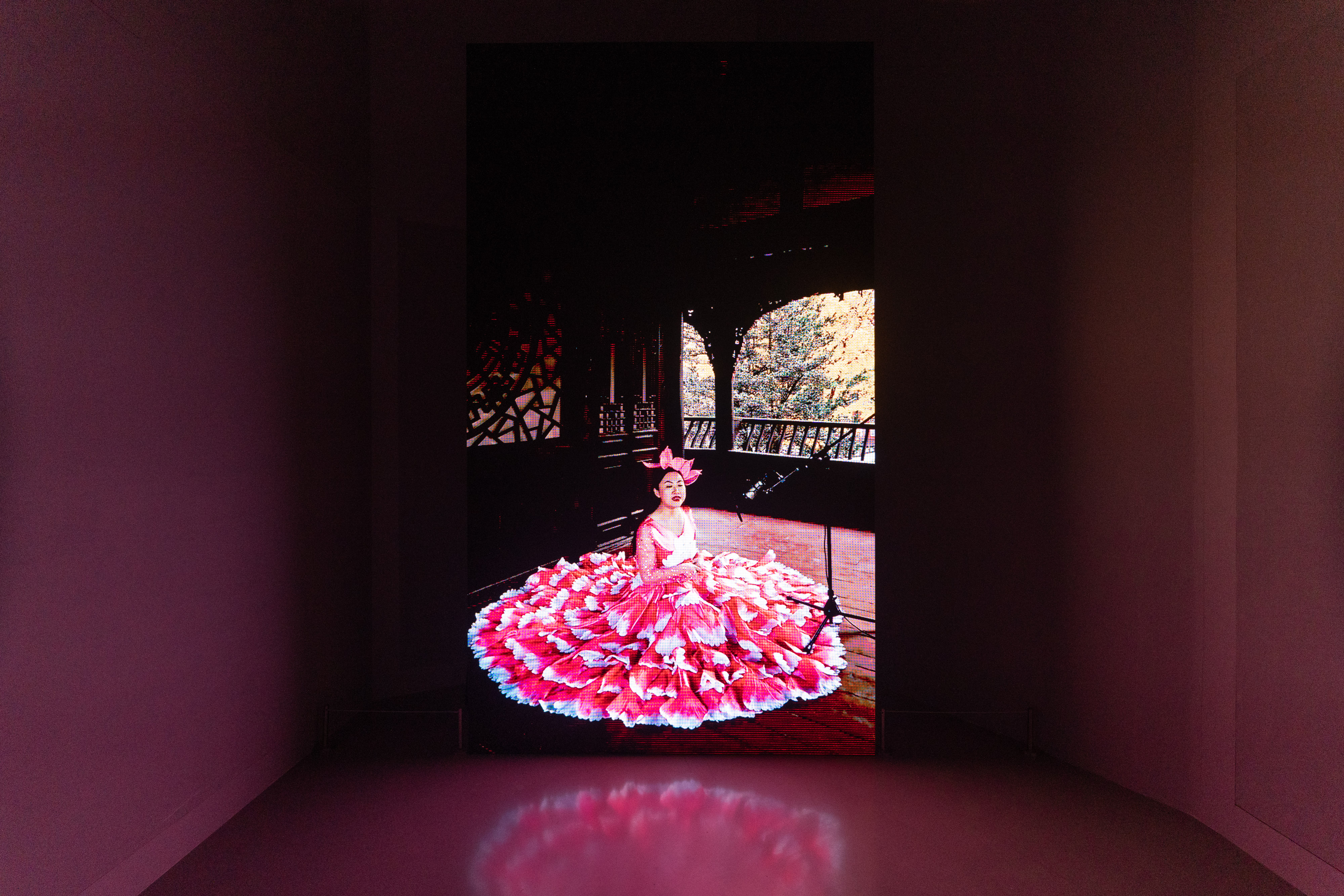
Pulsating Atom, 2019
Single channel HD video
Color, sound
14 min. 12 sec.
Courtesy of the artist and Kiang Malingue Gallery
Born in 1987 in Yunyang, a district of Chongqing, Tao Hui creates immersive video installations in which he closely examines and depicts movements that transcend geographical, cultural and identity boundaries. He explores themes such as the relationship between society and the individual, and the forgotten reality of marginalised communities.
The narratives that Tao Hui imagines for his works are based on memories, whether personal, collective or simply invented, and encourage viewers to reflect on their own social and cultural histories. In Pulsating Atom, the artist addresses the frenzy of social networking, in particular the global success of TikTok, which allows users to view, produce, reproduce and share short videos. The installation combines images of a gala singer, played by a Chinese opera singer, with film clips that have no real connection, just like the people who interact with each other through videos posted on the app. In this way, and as the title suggests, Pulsating Atom reflects the atomisation of society, and the dissonance between the increasing exchanges that take place and the growing sense of loneliness. By juxtaposing these disparate sources, Tao Hui highlights the paradox of these online productions, which offer TikTok users a simulated, ultra-connected reality in which they ultimately find themselves isolated – alone despite being surrounded by others.
- Read more about
- Log in or register to post comments